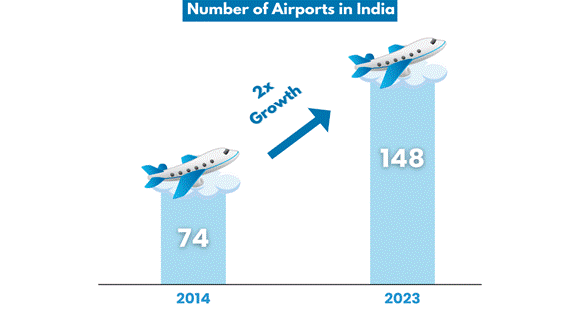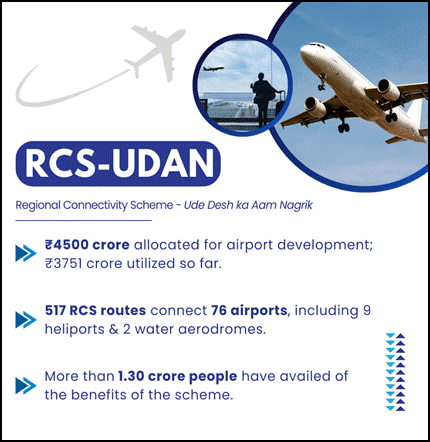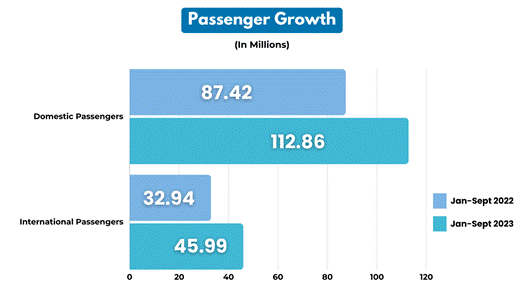Ministry of Civil Aviation
India’s Soaring Skies: Booming Aviation Sector
Operational Airports Double in 9 Years to 148
“The last 9 years have been transformative for India’s aviation sector. Existing airports have been modernised, new airports have been built at quick pace and record number of people are flying.”
~ Prime Minister Narendra Modi
Introduction
India’s aviation sector is experiencing a meteoric rise, fuelled by soaring demand and the government’s unwavering commitment to its growth through supportive policies. The industry has undergone a remarkable transformation, shedding its previous limitations and evolving into a vibrant and competitive sector. This dynamic shift has propelled India to the forefront of the global aviation ecosystem, becoming the third-largest domestic aviation market in the world, after the USA and China.
The government’s commitment to nurturing aviation growth has been instrumental in this success story. A series of strategic initiatives have been implemented, each designed to empower the industry and unlock its full potential.

Proactive Infrastructure Development
India’s aviation industry has experienced significant growth in the past 9 years. The number of operational airports in the country has doubled from 74 in 2014 to 148 in April 2023. The springboard for this growth has been the government’s policies and initiatives. One such initiative is the Regional Connectivity Scheme – Ude Desh ka Aam Nagrik (RCS-UDAN) launched in 2016, which aims to provide connectivity to unserved and underserved airports of the country through the revival of the existing airstrips and airports.
The Indian government is also placing a strong emphasis on sustainability. This is evident in the recent achievements of Delhi and Mumbai airports, both of which have been awarded the prestigious Level 4+ Carbon Accreditation. This recognition highlights their commitment to reducing their carbon footprint and promoting responsible aviation practices.
Regional Connectivity Scheme – UDAN
 At the heart of this expansion lies the Regional Connectivity Scheme (RCS) – UDAN (Ude Desh ka Aam Nagrik). The scheme has undergone several successful iterations over the past six years, focusing on connecting underserved and unserved regions of India. By reviving existing airstrips and airports, UDAN aims to bring essential air travel access to previously isolated communities and boost regional economic development. With a ten-year operational plan, UDAN intends to ensure equitable access to air travel for all Indians.
At the heart of this expansion lies the Regional Connectivity Scheme (RCS) – UDAN (Ude Desh ka Aam Nagrik). The scheme has undergone several successful iterations over the past six years, focusing on connecting underserved and unserved regions of India. By reviving existing airstrips and airports, UDAN aims to bring essential air travel access to previously isolated communities and boost regional economic development. With a ten-year operational plan, UDAN intends to ensure equitable access to air travel for all Indians.
RCS-UDAN is contributing to the growth of the civil aviation industry as four new & successful airlines have come up in the last 6 years. The scheme has helped airline operators to begin operations and develop a sustainable business model. Additionally, it’s providing opportunities to small regional airlines to scale up their businesses and their successful run is evidence of the fact that the scheme is creating an amiable ecosystem conducive to airline business.
Progress so far (As of December 04, 2023)
- Rs 4500 Crores have been allocated for the development of airports in the country under the Scheme, out of which Rs. 3751 Crores have been utilized since its inception.
- 517 RCS routes have so far commenced operations connecting 76 airports, including 9 Heliports & 2 Water Aerodrome.
- More than 1.30 crore people have availed of the benefits of the scheme.
- Rs 1000 crore has been allocated in the Budget 2023-24 for the revival and development of 50 additional aerodromes in the country.
Passenger Growth
The aviation industry is experiencing a remarkable resurgence post-Covid, fuelled by a surge in passenger demand. From domestic to international travel, air travel is witnessing an unprecedented increase in passenger volume, indicating a robust recovery and a promising future for the sector.
- From January to September 2023, domestic airlines carried 112.86 million passengers, a 29.10% increase from 87.42 million passengers carried during the same period in 2022.
- Between January and September 2023, airlines carried 45.99 million international passengers, a significant 39.61% increase compared to the 32.94 million passengers carried in the same period of 2022.

Carbon Neutrality Initiatives
The Ministry of Civil Aviation (MoCA) has taken initiatives to work towards Carbon neutrality and achieving net zero carbon emissions at airports in the country by way of standardizing the Carbon Accounting and Reporting framework of Indian Airports. For this purpose, airport operators with scheduled operations have been advised to map the carbon emission at their respective airports and to work towards carbon neutrality and net zero emission in a phased manner.
MoCA is encouraging developers of new Greenfield airports, in collaboration with respective state governments, to prioritize carbon neutrality and net zero emissions in their development plans.
With the above efforts of the Government of India, Airports like Delhi, Mumbai, Hyderabad, and Bengaluru have achieved Level 4+ as well as higher Airports International Council (ACI) Accreditation and have become Carbon neutral. Additionally, 66 Indian Airports are operating on 100% Green Energy.
References:
- https://www.civilaviation.gov.in/
- https://www.civilaviation.gov.in/sites/default/files/2023-11/Monthly%20Summary%20October%202023%20English%20version.pdf
- https://pib.gov.in/PressReleasePage.aspx?PRID=1982288
- https://pib.gov.in/PressReleasePage.aspx?PRID=1918943
- https://pib.gov.in/PressReleasePage.aspx?PRID=1982287
- https://pib.gov.in/PressReleasePage.aspx?PRID=1971506
- https://pib.gov.in/PressReleasePage.aspx?PRID=1773045
- https://static.pib.gov.in/WriteReadData/specificdocs/documents/2022/oct/doc20221012116801.pdf
- https://pib.gov.in/PressReleasePage.aspx?PRID=1920389
- https://pib.gov.in/PressReleaseIframePage.aspx?PRID=1943211#:~:text=Government%20of%20India%20has%20accorded,(Jewar)%20in%20Uttar%20Pradesh%2C



